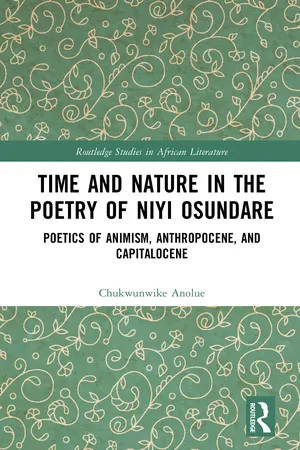
Time and Nature in the Poetry of Niyi Osundare
Poetics of Animism, Anthropocene, and Capitalocene
- 192 pages
- English
- ePUB (mobile friendly)
- Available on iOS & Android
Time and Nature in the Poetry of Niyi Osundare
Poetics of Animism, Anthropocene, and Capitalocene
About this book
This book provides an ecocritical analysis of the poetry of the famous Nigerian poet Niyi Osundare. It interrogates the intricate interface between time and nature in 11 of Osundare's defining poetry collections. This is a book of postcolonial ecocriticism from an African perspective. It brings together the ecocritical theory of animism and theories of geologic time in the discussion of Osundare's poetry. Osundare shows that animism has a lot to offer in enriching human understanding of the ecosystem. And while he eloquently catalogues problems undermining the health of the earth in this age of the Anthropocene and the Capitalocene in his poetry, he also holds on to the hope of a better future. The book concludes that Osundare's optimism is what informs his use of poetry to press humankind to rise to the duty of salvaging the environment.
Deploying an interdisciplinary approach that stretches across the fields of literature, religion, geology, physics, economics, and anthropology, this book will be an important read for those looking for fresh ways to understand Osundare's poetry and African nature writing.
Frequently asked questions
- Essential is ideal for learners and professionals who enjoy exploring a wide range of subjects. Access the Essential Library with 800,000+ trusted titles and best-sellers across business, personal growth, and the humanities. Includes unlimited reading time and Standard Read Aloud voice.
- Complete: Perfect for advanced learners and researchers needing full, unrestricted access. Unlock 1.4M+ books across hundreds of subjects, including academic and specialized titles. The Complete Plan also includes advanced features like Premium Read Aloud and Research Assistant.
Please note we cannot support devices running on iOS 13 and Android 7 or earlier. Learn more about using the app.
Information
Table of contents
- Cover Page
- Half Title page
- Series Page
- Title Page
- Copyright Page
- Dedication
- Contents
- Acknowledgements
- 1 Introduction
- 2 The Sacred and the Profane: Time and Nature as Autobiography
- 3 The Spoken Word and Creation
- 4 Nigeria and the Anthropocene
- 5 Living in the Capitalocene: A Nigerian Example
- 6 Concluding Reflection
- Index